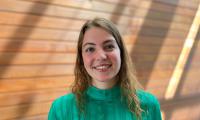Freja Tang Severinsen
DARE Fellowship: Immune function in lymphoma patients
Freja Tang Severinsen’s research concerns the long-term effects on the immune system when lymphoma patients receive a stem cell transplant or CAR-T therapy with genetically modified T cells.
The standard treatment for lymphoma is chemotherapy – actually, cell toxin – and it has the desired effect in 60–70% of patients.
Today, those who do not benefit from chemotherapy are offered a bone marrow transplant as so-called second-line therapy.
To begin with, some of the patient’s own stem cells are collected, and the patient is then given an extremely strong dose of chemotherapy to kill the cancer cells.
However, the dose is so strong that it also depresses the immune system.
Therefore, the patient then receives a transplant of their own stem cells, which generate a “new” immune system. For some patients, this treatment leads to long-term survival.
‘I’ll be studying the function of this “new” immune system that lymphoma patients establish after a bone marrow transplant,’ Freja Tang Severinsen explains.
Freja is 24 years old and is studying medicine at Aalborg University. She will be working in the laboratory of her American mentor, Surbhi Sidana, a doctor and researcher specialising in blood and bone marrow disorders at Stanford University.
There have been many studies of immune system function after a marrow transplant. However, these are usually conducted during the first year after therapy.
By contrast, Freja Tang Severinsen will conduct a long-term study of immune system function after treatment, by combining data from American and Danish patient databases:
‘One of the questions I’ll be seeking to answer is “when does a lymphoma patient’s immune system return to normal after a marrow transplant?” – to the extent that it does return to normal,’ she says.
In the patient databases to which she is given access, she will look for infections to see whether lymphoma patients have particular difficulty in combating specific bacteria in the years after a marrow transplant:
‘And if this does prove to be the case, we could perhaps prevent some of these infections with antibiotic prophylaxis,’ says Freja Tang Severinsen.
Finally, she will address a number of immune system-related issues in cancer patients who have received CAR-T therapy.
CAR-T is also a second-line therapy and involves collection of so-called “killer cells”– T cells – from the patient.
A type of virus is genetically engineered into the cells, which are then propagated in a laboratory and given back to the patient through a drip.
The engineered cells can recognise surface structures of cancer cells and begin destroying them.
CAR-T is a technically complex and costly therapy – one treatment amounts to around DKK 4 million.
Over the past ten years, CAR-T has been used to treat a limited number of lymphoma patients, for example in the USA.
In Denmark, in the spring of 2021, Rigshospitalet, University of Copenhagen, successfully used CAR-T to treat four children and adolescents with advanced leukaemia.
‘The survival rate compared with marrow transplants is significantly higher when CAR-T is used as a second-line treatment for lymphoma,’ Freja Tang Severinsen explains.
‘There is a 40–50% survival rate after five years, compared with 20% in the case of second-line treatment with a marrow transplant. However, CAR-T does have some side effects. It also kills the cells that produce antibodies against viruses, bacteria and fungal infections. I’ll be studying the data of around 600 American CAR-T patients to seek to identify whether these side effects make patients particularly vulnerable to certain microorganisms.’
Freja Tang Severinsen’s Danish mentor is Tarec El-Galaly, professor and consultant physician at the Department of Haematology, Aalborg University Hospital.
